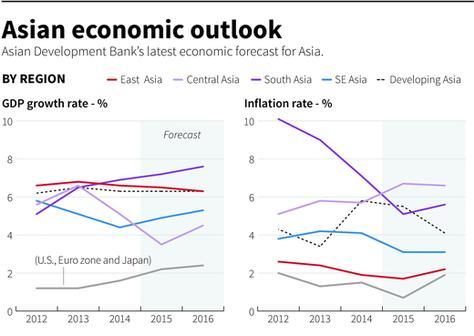14 charts on the Asian economy
Stay up to date:
Economic Progress
Globalizing Chinese companies are looking beyond the West for growth and acquisitions. Japanese investors are doing the same – due to years of low inflation at home. As ASEAN economies pick up steam, they seem like a natural match for growth hungry companies and investors from across Asia.
This is just one of the stories that will be discussed at the World Economic Forum on East Asia 2015, which is taking place in Jakarta, Indonesia, from 19-21 April.
Here’s the story in 14 graphs.
Due to increased growth in Southeast Asia, the GDP growth rates in ASEAN countries are converging with that of China – close to 6%.

China’s slowing growth makes its companies less optimistic than those in other Asian countries…

Chinese businesses keep on exporting more and more goods and services despite their neutral outlook…

…making for a highly positive Chinese trade balance, and a lot of excess capital.

The consequence of this excess capital is that Chinese foreign M&A is at an all-time high…

…with most acquisitions happening in developed markets such as the U.S., Canada and Australia, as well as nearby markets such as Hong Kong.

Special attention goes to acquiring technology, expertise and access to Western markets, as evidenced by acquisitions such as Pirelli, Volvo or AMC.

Japan, from her side, has faced low inflation for years, leaving the Central Bank to ease money supply, and the government to hike sales taxes.

This has left Japanese investors hungry for return, with few options at home. In the first two months of 2015 alone, they bought foreign assets worth over $5bn.

The quest of the two Asian regional powers for growth and return – China and Japan – could be met in ASEAN. Indeed, ASEAN countries economies’ are gaining traction.

Consumers in most ASEAN nations are optimistic.

And ASEAN companies are increasingly taking on credit to further fuel growth.

These positive signs are further reflected in and fuelled by an increase in Foreign Direct Investment in the region.

Making it very plausible for Chinese and Japanese investors and companies to invest in ASEAN and make intra-Asian trade and investment Asia’s next big economic story.
What is certain, is that M&A activity in Asia-Pacific (not including Japan) is off to a record start this year. Alongside China and Hong Kong, there has also been a lot of activity in Australia, Singapore and Korea.

Is this all a sign of more to come?
Author: Peter Vanham is Senior Media Manager at World Economic Forum.
Image: Hanjin Shipping’s container terminal is seen at the Busan New Port in Busan, about 420 km (261 miles) southeast of Seoul August 8, 2013. REUTERS/Lee Jae-Won
All charts in this post are from Reuters Graphics.
Don't miss any update on this topic
Create a free account and access your personalized content collection with our latest publications and analyses.
License and Republishing
World Economic Forum articles may be republished in accordance with the Creative Commons Attribution-NonCommercial-NoDerivatives 4.0 International Public License, and in accordance with our Terms of Use.
The views expressed in this article are those of the author alone and not the World Economic Forum.
Forum Stories newsletter
Bringing you weekly curated insights and analysis on the global issues that matter.
More on Economic GrowthSee all
Dave Neiswander
April 28, 2025
Alem Tedeneke
April 25, 2025
Michael Eisenberg and Francesco Starace
April 25, 2025
John Letzing
April 25, 2025
Luis Antonio Ramirez Garcia
April 24, 2025
Pierre-Olivier Gourinchas
April 23, 2025





